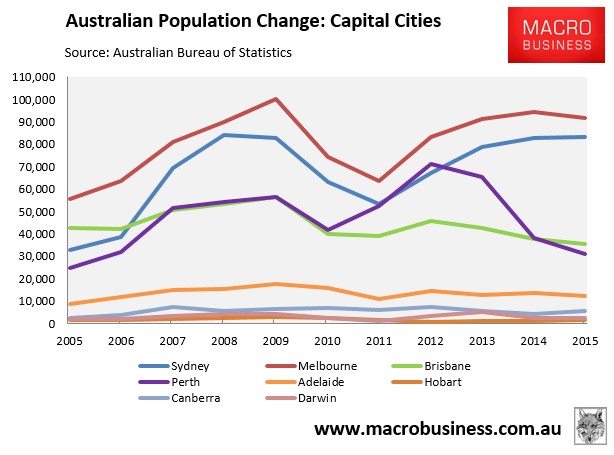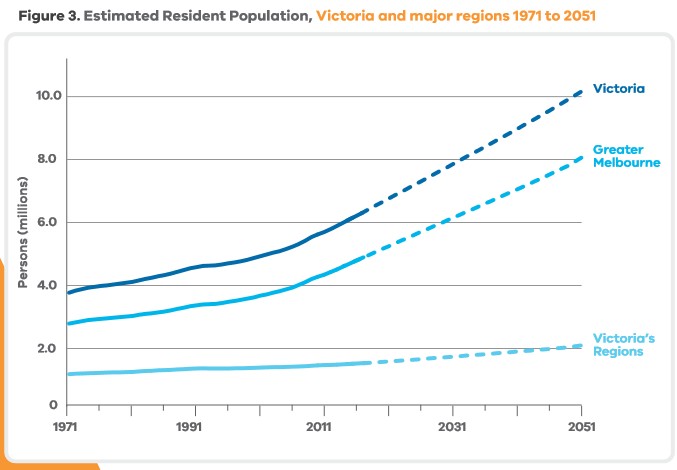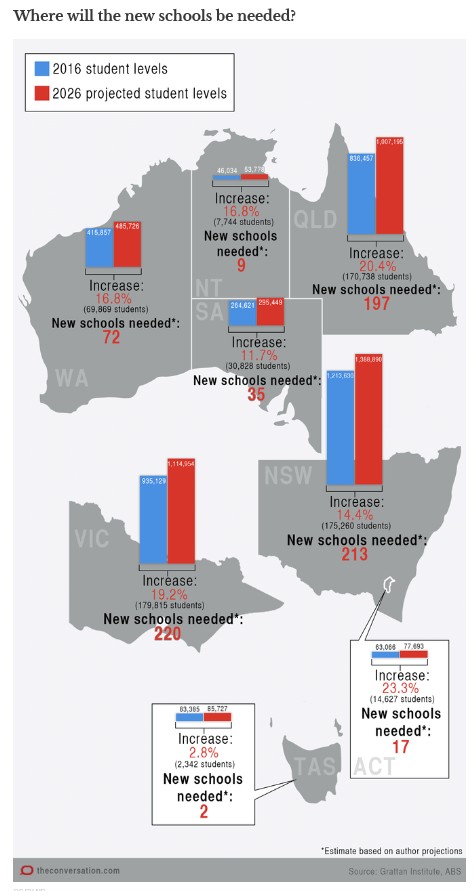The lack of planning and foresight to cope with the never-ending population (immigration) influx never ceases to amaze.
Over the past decade, Melbourne’s population has ballooned by more than 850,000 people, or nearly one-quarter, driven mostly via immigration (see next chart).

The city’s population is also projected by the Victorian Government to balloon by 75% over the next 36 years to 8 million people, again mostly via immigration (see below chart).

The collateral damage from this high immigration program has been felt far and wide, ranging from worsening traffic congestion, deteriorating housing affordability, and the overall erosion of public services.
One such area that has been badly affected is Melbourne’s public schools, which are now suffering from chronic over-crowding as they struggle to keep pace with the rampant population growth.
In June, it was reported that some Melbourne school students were being forced to work on cushions on the floor and play in neighbouring parks because there simply is not the space to accommodate them. The situation was most acute in Melbourne’s inner-city areas, where schools are simply being overrun by the student influx.
And back in February, Peter Goss, School Education Program Director at the Grattan Institute, penned an excellent article in The Conversation assessing the upcoming shortage of schools across Australia’s capital cities as the nation’s population balloons. This article estimated that the number of school students would balloon by 650,000 (17%) by 2026, which would require the building of an additional 400 to 750 new schools (up from 9,400 currently). Victoria (mostly Melbourne) alone would need an additional 220 schools to cope with an additional 19% of students over the next decade (see below graphic).

Melbourne’s inner city would be worst affected, according to Grattan:
In the inner city, the big issue is the cost and scarcity of land… Governments have been much worse at planning for the booming number of inner-city children…
Worse is to come, especially in Melbourne. Melbourne’s five most central local government areas will each see a 30% to 60% increase in student numbers over the next decade… Inner-city parents in urban redevelopment zones are the most likely to have problems getting their children into a government school.
Today, The Age has reported that the Victorian Government has announced that it will build four new inner-city schools in a belated attempt to alleviate some of the pressures of rampant student growth:
There’s an anxiety that grips Docklands families as their children grow up.
They have two options – move house when their child reaches prep, or a long, annoying commute in peak hour traffic to a school outside their neighbourhood…
The Andrews government… announced on Tuesday that “over the next few years” a primary school in the Docklands, a primary and secondary school at Fishermans Bend and a new primary school in North Melbourne would be built to accommodate the student boom.
The government will also purchase a new site to expand the popular Albert Park College.
It follows a relentless campaign from Docklands parents, who have been crying out for a new school for 15 years. Successive governments have promised these families a school, and three studies into the sought-after education facility have been commissioned.
Frustrated parents at North Melbourne Primary – who claim free range chickens have better rights than their children in cramped classrooms – have also been fighting for new inner-city schools to ease the overcrowding. Students have complained of sore backs from sitting on the classroom floor, because there are not enough seats…
Education Minister James Merlino said… “Enrolment growth right across Melbourne and Victoria is just extraordinary… We are seeing that pressure right here in the inner-city, in the growth corridors of Melbourne and in our growing regional cities”…
Mr Merlino said the new schools would create 5000 new places for students.
Too little too late, I’m afraid. Creating 5,000 new places for students will barely hit the sides given nearly 180,000 places will be needed statewide over the coming decade, according to Grattan.
All of this, yet again, highlights Australia’s dysfunctional population ponzi.
The Federal Government massively ramped-up immigration from 2003 which, when combined with the mini baby boom encouraged by the baby bonus, is leading to surging demand for schooling.
However, the states have been unable to accommodate this growth – due in part to incompetence, but also through lack of funds courtesy of Australia’s famous vertical fiscal imbalance, whereby the federal government collects most of the revenue.
This dysfunction is arguably most apparent across inner city areas. The states have been successful in forcing urban consolidation and infill development, as evidenced by the proliferation of apartment development across our major cities. However, they have been totally unsuccessful in providing the necessary infrastructure to accommodate this growth, be it schools or transport infrastructure.
The fact that Melbourne’s Docklands does not already have its own school – despite a decade-plus of rampant development – is testament to this incompetence, as is the new Fisherman’s Bend mega-development, which will eventually be twice the size of Docklands but ridiculously did not have land set aside for schools when initially launched!
To make matters even worse, the Turnbull Government recently relaxed visa rules to allow 6 year-old foreign students and their guardians visa entry into Australia’s primary schools, thus adding to the demand pressures.
Ongoing population growth without adequate planning and investment means more time lost in traffic, more expensive (and smaller) housing, less services (e.g. health and education), and overall lower living standards.
The equation is that simple, but too often ignored by our politicians and policy makers, who prefer to take the short-term sugar hit from growth while existing residents suffer the long-term consequences.

